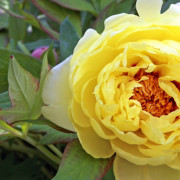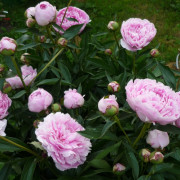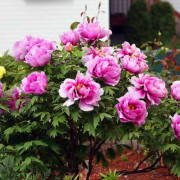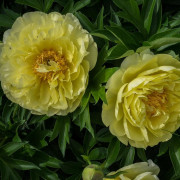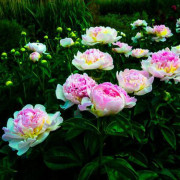Peony Coral Charm (Paeonia Coral Charm) - features of breeding varieties
Content:
Peonies are perennial flowers that not only decorate the area with lush flowering, but also fill it with a delicate delicate aroma. There are many varieties of this plant. A separate group of "Coral peonies" is distinguished by varieties that have inflorescences of amazing beauty, exuding a pleasant smell. One of the brightest representatives of the variety is the Coral Charm peony. Before planting it, you should learn more about both the characteristics of the plant and the methods of growing it.
Peony Coral Charm (Paeonia coral charm)
The history of the emergence of the Coral group of peonies is associated with the names of two scientists - Arthur Sanders and Sam Wissing. If the first managed to get specimens with salmon and coral shades of inflorescences, then the second went further and created a whole group of such varieties, which included the Coral charm peony.
Description of the plant
Peony Coral charm is a compact herb with a height of 0.8-1.1 meters. Shoots are well developed, erect. Leaves of a typical form for peonies are trifoliate with veins. The color of the leaf plate is dark green, the surface is glossy.
The main attraction of the variety is in the color and shape of the inflorescences. They are quite large - 16-21 cm in diameter. They are bowl-shaped and semi-double in shape. The color of the petals during the bud dissolving changes from dark coral to light salmon.
On the eve of wilting, the petals may acquire a milky hue and become white around the edge. This was the reason for the appearance of the name "peony lactic-flowered Coral charm". The middle of the flower is filled with small yellow stamens. In June, active flowering begins and during this period the plant spreads a fascinating aroma.
Advantages and disadvantages
Coral Sharm is almost perfect. It has a lot of advantages, which include:
- cold resistance;
- beauty and aroma of inflorescences;
- ease of reproduction;
- long and abundant flowering;
- good disease resistance;
- moderation in care.
The disadvantages include the following points:
- exactingness to the ground;
- the need for regular feeding.
These factors can hardly be called the disadvantages of this variety. All varietal peonies have similar qualities. In addition, proper site preparation and planting care will completely eliminate them.
Use in landscape design
Peonies are widely used in landscape design, not only due to the beauty of the inflorescences, but also due to the preservation of decorativeness until frost.
These perennials are often included in continuous flowering compositions, used to create low hedges and borders. It is good to plant peonies in the foreground in the rose garden - this allows you to extend the decorative effect of the composition and decorate the bare shoots of tall varieties of roses.
Growing and planting in open ground
Most often, peonies are propagated by dividing the root system.You can use both its whole parts and segments - root cuttings.
In order to get new specimens of peony, an adult plant is dug up and the soil is partially carefully removed from the roots. After that, the rhizome is washed in water and left to dry for a day. When the roots are dry and slightly soft, dividing or cutting the cuttings is carried out.
Preparing for landing
Before planting plants in the ground, you need to prepare for it and think over everything. This implies several important points:
- Landing time. Rhizomes can be planted in the ground in both spring and autumn. The most favorable period is the end of September.
- Accommodation. For peonies, you should choose a closed area with fertile soil. It is permissible to place plants in a place that is lit in the first half of the day, and in the second is in light partial shade.
- Soil preparation. On heavy or clayey soil, peonies grow poorly, and sometimes refuse to bloom. To increase fertility and improve the structure of the soil, it is necessary to add rotted dry manure and sand to the site. Before planting, a dose of complex mineral fertilizers is applied.
- Plant preparation. After removing the root system from the soil, it is washed and dried. Then it is necessary to examine the roots and cut off the damaged and too long processes. Before planting, it is recommended to soak part of the root system or cuttings cut from it in a growth stimulant solution.
Proper preparation for landing is half the battle. When planting in the ground, you must show no less diligence in order to enjoy fragrant flowers next summer.
Landing
After carrying out all the preparatory measures, you can start planting peonies in open ground. The process itself is carried out step by step:
- Dig holes 1/3 larger than the root system.
- A layer of drainage is poured from broken brick, small pebbles or expanded clay.
- Sprinkle with a mound of soil, previously mixed with compost and sand in a ratio of 2/1/1.
- Place the rhizome, distributing root processes over the surface (if we are talking about cuttings, they are placed on the top of the mound).
- Gently watered around the perimeter of the mound.
- The planting hole is closed up with soil residues and the surface is compacted.
- Repeated watering is carried out and the surface around the plantings is mulched.
When planted with a part of the root system in the fall, the next year the flower will actively start growing. Before the onset of cold weather, watering is carried out several times, and then covered with spruce branches for the winter. Although the peony Coral charm is frost-resistant, young plantings need shelter.
Seed propagation
Seed propagation of peonies is relevant only in one case - to obtain a new variety or intermediate results for breeding. As a rule, flowers of different varieties are used and artificial pollination is carried out.
Growing peonies from seeds is not as difficult as it is for a long time. You can wait for the flowering of such plants only for 5-6 years of life. That is why the root division method is a priority.
Outdoor care
Almost all peonies are quite unpretentious. With proper placement and high-quality preparation of the site, they will need a minimum of attention from the grower.
Several activities will be required during the season.
| Watering | It is carried out as the soil dries up with warm, settled water into the grooves around the plant. |
| Top dressing | Complex mineral fertilizer is applied 2-3 times, from early spring to the beginning of budding. As soon as the buds begin to form, add a mullein solution (1/5), and after the end of flowering, phosphorus-potassium fertilizers. |
| Loosening and mulching | To maintain a loose soil structure, regular loosening is carried out. An alternative to this procedure can be mulching the plantings. This will help retain moisture in the soil, prevent crust formation and protect the roots from damage when loosening. |
| Preventive treatments | It is required to carry out periodic spraying with preparations for aphids and ants, and spring treatment with Bordeaux liquid is also recommended. |
Observing these simple rules of care, you can achieve active growth and flowering of the Coral charm peony. We can say that this flower does not have individual requirements - all events are identical to the standard ones for many open field flower crops. This makes growing the plant very easy and makes it possible even for novice florists.
Peony Blossom Coral Charm
From the group of coral peonies, the Coral Sharm variety blooms a little later than the others - in mid-June.
This is the peak of the flower's activity period, which lasts from March to October. In early November, the plant begins to gradually enter a state of dormancy and prepare for the winter cold.
Care during and after flowering
In addition to the fact that the plant needs additional feeding during flowering, it is imperative to monitor the moisture content of the soil. Withered flowers should also be removed to stimulate the formation of new buds and maintain the decorative effect of the peony.
After flowering, sparing pruning is carried out and wilted flowers along with peduncles are removed.
What to do if it does not bloom
Sometimes it is not possible to wait for the Coral charm peony to bloom. There can be several reasons for this behavior of a plant:
- lack of light;
- poor or heavy soil;
- lack of dressing.
Diseases and pests can also cause buds to be missing. That is why it is advisable to carry out preventive spraying several times per season.
Autumn care after flowering
It is autumn that is the most favorable period for transplanting or breeding peonies. Transferring an adult plant to a new place is carried out in the same way as planting parts of a bush after dividing.
In late autumn, before the onset of frost, all the shoots are pruned, leaving only short stumps. After that, the flower is covered with a layer of leaves or spruce branches.
Do not neglect the shelter, because not only severe frosts, but also sudden temperature changes can be fatal for a plant. Therefore, it is better to show extra care than neglect it and lose the flower.
Diseases and pests
Coral Charm herbaceous peony is highly resistant to a number of diseases typical of flower crops. As a preventive measure, it is enough to spray with Bordeaux liquid in the spring.
Unfortunately, pests hit the peony quite often, especially ants and aphids. Therefore, preventive spraying is necessary. If peonies are part of a multi-species flower arrangement, then spraying is carried out for all plants from its number.
Coral Charm is a beautiful and enchanting representative of the coral peonies group. Its terry flowers of an unusually delicate shade, combined with an exquisite aroma, make an unforgettable impression.
It is not so difficult to grow this plant - it is enough to water it in a timely manner, apply top dressing and spray for prevention. At the same time, the labor invested will certainly be rewarded.














